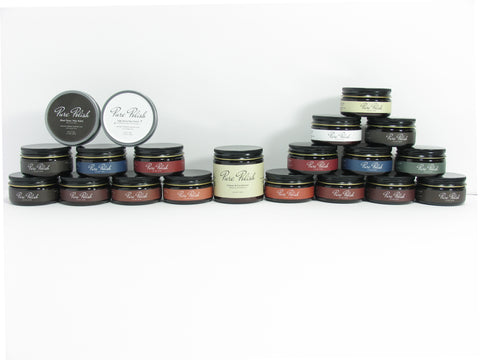What Goes Into Leather Polish?
We were asked this question in a comment on the Goodyear Welt Subreddit recently, and thought we'd elaborate a bit more about what goes into polish in-general, as well as what we specifically add to ours – ie. what makes Pure Polish special.
All leather polish must have four basic ingredients:
- Solvent: usually Naphtha or Turpentine
- Oil: usually Neatsfoot (bovine tallow) or Mink oil
- Wax: usually Beeswax and/or Carnauba Wax
- Color: usually chemical dyes
Solvent has two main purposes:
- Soften and ease the spread of the polish
- Dissolve and clean the old waxes.
Wax has four main purposes:
- Cosmetic, for adding a shine.
- Protection, so that if you scuff your shoe on something, you aren’t scuffing the leather, just the wax.
- Color stabilization. It allows you to replenish or change the color of the leather, as it is what holds the dye or pigment, rather than applying dye or pigment directly to the leather.
- Proportion moderation. It is mixed at a proportion determined by the manufacturer to provide conditioning, protection, and/or shine. Can you condition your leather without wax, using oil only? Yes, but you run the risk of over conditioning. Wax helps you moderate that proportion through other application/textural limiters (you could spread cream on very thick, but it will usually get over-sticky before getting over saturated).
Can polish be made without conditioning oil? Yes, that’s usually a High Shine or Mirror Gloss Product, designed for maximum cosmetic appeal.
Can polish be made without solvent? Yes, but then you’re using other products like borax to soften the wax.
Can polish be made without wax? Conditioner can. But again, you are limiting your protection, running the risk of over application, and coloring the leather directly.
Can Polish be made without color? Yes, that’s Neutral, High Shine, or Cleaner/Conditioner type products.
Pure Polish Difference
Our products contain only the following all natural, non-toxic, pleasant smelling ingredients:
Solvent –

We use food grade orange terpenes (d-Limonene). Orange oil contains the raw oil collected from the citrus peel during the juicing extraction process. Once orange oil has been extracted from the rind, d-Limonene is separated from sesquiterpenes, other monoterpenes, and is purified by high vacuum distillation to produce food grade d-Limonene. The orange citric acid has a pH value of approximately 3.5, similar to the pH value of vegetable tanned leather which is approximately 3.2 (chrome tanned leather has a pH of approximately 3.8).
Orange oil contains citric acid and ascorbic acid, both of which are preventative antioxidants, and assist in oxidative stability. Orange oil is considered a volatile oil because it evaporates relatively quickly (over a few hours) when exposed to air (not in a closed container); this allows it to act as a solvent, rather than a lubricant like coconut oil. Pure Polish will last well over a year, if the jar is only open during use (this is true of any shoe polish).
Oil –

We use organic extra-virgin coconut oil. Coconut oil is about 50 percent lauric acid, a rare medium-chain fatty acid, and is studied for its anti-fungal, anti-viral, and anti-bacterial properties. Overall, coconut oil contains 92% saturated fats (mink oil contains about 80% saturated fats). Saturated fat percentage is a major factor in determining oxidative stability; the higher the saturated fat percentage is the higher the oxidative stability (See Iodine Value below).
Coconut oil has a neutral pH balance (7.0), similar to mink oil (6.5).
Wax –

Our Beeswax is one of the most natural wax products available. Beeswax is the wax made by honeybees intended for the protection of their honeycombs. The main components in beeswax are palmitate, palmitoleate, and oleate esters of long-chain (30-32 carbons) aliphatic alcohols, with a ratio of 6:1 of triacontanyl palmitate to cerotic acid, the two principal components.

The Carnauba wax we use is a natural vegetable wax exuded by the leaves of a palm tree (copernicia cerifera) growing in Brazil. It is the hardest natural wax available, composed of wax esters (85%), free fatty acids, fatty alcohols and resins (15%). Our Carnauba wax is basically odorless.
Color –

We use Earth and Ocher pigments for our coloring. All of our coloring is safe, non-toxic, environmentally friendly, and free from chromium, cadmium, mercury, tin, arsenic, radium, lead or other hazardous materials.
Our Products

View our catalog, to see the assortment of products we make from these ingredients.

Are your products sold in China?
Are any of the ingredients, in your products, tested on animals?
Hi Beth – All of our products use beeswax. However, we use smaller scale sources. But, I would also like to clarify that these are leather care products. So, I may not understand what you’re referring to, with your description of a “vegan” leather shoe. Feel free to email me directly with any additional questions, maybe I can help clarify better.
Are any of your products suitable for vegan shoes (i.e. beeswax-free)?
Are the conditioner and cream polishes, including the waterproof version safe to use on cordovan?
I know for cordovan cream you want to avoid solvents so you don’t breakdown the right pore structure of the shell. How does the citrus solvent impact this?
Hi Ariel – We do not have any local distributors in Puerto Rico (yet), but can definitely ship it direct to you! Thanks for checking out the blog post :)